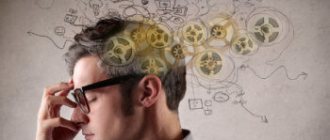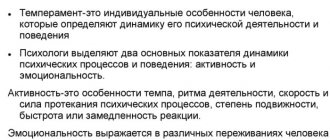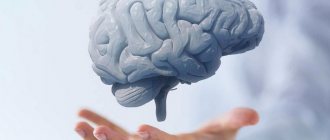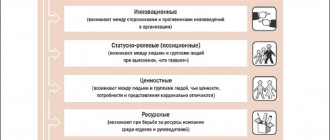Memory, main types, properties and patterns.
Memory is a form of mental reflection that consists of the accumulation, consolidation, preservation and subsequent reproduction of knowledge and skills, making it possible to reuse them in activities.
Memory Processes:
1.Memorization
- a memory process through which traces are imprinted, new elements of sensations, perceptions, thoughts or experiences are introduced into the system of associative connections.
Memorization can be voluntary or involuntary; the basis of voluntary memorization is the establishment of semantic connections - the result of the work of thinking on the content of the memorized material. Based on the nature of the connections (associations) underlying memory, memorization is divided into mechanical and meaningful .
Rote memorization is based on consolidating external connections through repeated repetition (memorization).
Meaningful memorization is based on establishing semantic connections between new material and already known material and between parts of this material.
2. Storage
- the process of accumulating material in the memory structure, including its processing and assimilation. Saving experience makes it possible for a person to learn, develop his perceptual (internal assessments, perception of the world) processes, thinking and speech.
3.Reproduction and recognition
- the process of updating elements of past experience (images, thoughts, feelings, movements). A simple form of reproduction is recognition - recognizing a perceived object or phenomenon as already known from past experience, establishing similarities between the object and its image in memory. Reproduction can be voluntary or involuntary. With involuntary, the image emerges in consciousness without a person’s effort.
4.Forgetting
- loss of the ability to reproduce, and sometimes even recognize, what was previously remembered. What is most often forgotten is what is insignificant. Forgetting can be partial (reproduction is incomplete or with an error) and complete (impossibility of reproduction and recognition). There are temporary and long-term forgetting.
Types of memory:
1. by sensory modality - visual (visual), motor (kinesthetic), sound (auditory), gustatory, pain;
2. in content - figurative, motor, emotional;
3. according to the organization of memorization - episodic and semantic, at their junction autobiographical, includes features of both; procedural;
4. according to time characteristics - long-term, short-term, ultra-short-term, operational (during the implementation and maintenance of certain activities), intermediate (ensures the preservation of information for several hours);
5. according to physiological principles - determined by the structure of connections of nerve cells (also long-term) and determined by the current flow of electrical activity of the nerve pathways (also short-term)
6. according to the presence of a goal - voluntary and involuntary;
7. according to the availability of funds - indirect and non-mediated;
8. by level of development - motor, emotional, figurative, verbal-logical.
Memory properties:
1. Accuracy 2. Volume 3. Speed of memorization processes
4. Speed of reproduction processes 5. Speed of forgetting processes
Patterns of memory:
1) The law of interest - interesting things are easier to remember.
2) The law of comprehension - the deeper you understand the information being remembered, the better it will be remembered.
3) The law of installation - if a person has given himself an instruction to remember information, then memorization will happen more easily.
4) Law of action - information involved in an activity (i.e. if knowledge is applied in practice) is remembered better.
5) The law of context - when information is associatively linked with already familiar concepts, new things are learned better.
6) The law of inhibition - when studying similar concepts, the effect of “overlapping” old information with new information is observed.
7) The law of optimal series length - the length of the memorized series for better memorization should not significantly exceed the volume of short-term memory.
 Law of edge - information presented at the beginning and at the end is best remembered.
Law of edge - information presented at the beginning and at the end is best remembered.
9) Law of repetition - information that is repeated several times is best remembered.
10) The law of incompleteness - unfinished actions, tasks, unsaid phrases, etc. are best remembered.
Patterns of memory
Patterns of memory (conditions for successful memorization and reproduction) are associated with forms of memory.
The conditions for successful involuntary memorization are: 1) strong and significant physical stimuli (the sound of a gunshot, bright spotlight); 2) what causes increased orienting activity
(cessation or resumption of an action, process, unusualness of the phenomenon, its contrast in relation to the background, etc.); 3) stimuli that are most significant for a given individual (for example, professionally significant objects); 4) stimuli that have a special emotional connotation; 5) what is most related to the needs of a given person; 6) something that is the object of vigorous activity. Thus, the conditions of a problem that we have been solving for a long time are remembered involuntarily and firmly.
But in human activity, more often there is a need to specifically remember something and reproduce it under appropriate conditions. This is voluntary memorization, in which the task is always set to remember, i.e., special mnemonic activity is carried out.
In the process of human development, voluntary memorization is formed relatively late (mainly during the period of schooling). This type of memorization develops intensively in learning and work.
The conditions for successful voluntary memorization are: 1) awareness of the significance and meaning of the memorized material; 2) identification of its structure, logical relationship of parts and elements, semantic and spatial grouping of material; 3) identifying the plan in verbal-textual material, supporting words in the content of each part of it, presenting the material in the form of a diagram, table, diagram, drawing, visual image; 4) the content and accessibility of the memorized material, its correlation with the experience and orientation of the subject of memorization; 5) emotional and aesthetic richness of the material; 6) the possibility of using this material in the subject’s professional activities; 7) setting the need to reproduce this material under certain conditions; material that acts as a means of achieving significant goals, plays a significant role in solving life problems, and acts as an object of active mental activity.
2) identification of its structure, logical relationship of parts and elements, semantic and spatial grouping of material; 3) identifying the plan in verbal-textual material, supporting words in the content of each part of it, presenting the material in the form of a diagram, table, diagram, drawing, visual image; 4) the content and accessibility of the memorized material, its correlation with the experience and orientation of the subject of memorization; 5) emotional and aesthetic richness of the material; 6) the possibility of using this material in the subject’s professional activities; 7) setting the need to reproduce this material under certain conditions; material that acts as a means of achieving significant goals, plays a significant role in solving life problems, and acts as an object of active mental activity.
When memorizing material, a rational distribution of it over time and active reproduction of the memorized material are essential.
If it is impossible to establish semantic connections in heterogeneous material, artificial methods to facilitate memorization are used - mnemonics
(from
the Greek
mnēmē – memory and technē – art; art of memorization): creation of auxiliary artificial associations, mental placement of memorized material in a well-known space, familiar pattern, easy-to-remember rhythmic tempo. Since school years, everyone has known the mnemonic technique for memorizing the sequence of colors of the light spectrum: “Every Hunter Wants to Know Where the Pheasant Sits.”
Voluntary memory is memory that is purposefully organized. Research shows that a person easily holds and reproduces only 3-4 isolated objects (with their simultaneous perception). The limited scope of simultaneous retention and reproduction of material is due to retroactive and proactive inhibition (inhibition arising from previous and subsequent influences).
If the subject is given a series of 10 syllables, then the first and last syllables are remembered more easily, and the middle ones - worse. What explains this fact? The first elements do not experience inhibition from previous impressions, and the last members of the series do not experience inhibition from subsequent elements. The middle members of the series experience inhibition both from the preceding ones (proactive inhibition) and from the subsequent elements (retroactive, inverse inhibition). This pattern of memory (better memorization of extreme elements) is called the edge factor.
If the memorized series consists of four elements, then the first, second and fourth are remembered first, the third is worse. Therefore, in the quatrains you should pay attention to the third line - the “Achilles heel” of the structure. It is characteristic that it is in the third lines of quatrains that poets often allow violations of meter in order to attract increased attention to it. This is what, for example, the first quatrain of N. M. Yazykov’s poem “Muse” sounds like:
The goddess of strings survived
Gods and thunder and damask steel.
She didn't let her beautiful hands into chains
Centuries of tyranny and debauchery.
It's hard to remember a list of 18 different items. But listing the purchases of Nozdryov, the hero of Dead Souls, does not turn out to be too difficult to remember. The author himself helps us with this, providing the necessary contrastive organization of the list. “If he (Nozdryov) at the fair was lucky enough to attack a simpleton and beat him, he bought a bunch of everything that had previously caught his eye in the shops: clamps, smoking tar, calico, candles, scarves for the nanny, a stallion, raisins, a silver washstand, Dutch canvas, fine flour, tobacco, pistols, herrings, paintings, sharpening tools, pots, boots, earthenware - as much as there was enough money.”
When moving from memorizing one complex material to memorizing another, it is necessary to take breaks (at least 15 minutes), which prevent retroactive inhibition.
The assumption that traces do not disappear at all, but are only inhibited under the influence of other influences, is confirmed by the phenomenon of reminiscence (from the Latin reminiscentia - memory). Often, when reproducing material immediately after perceiving it, the number of elements retained in memory is less than the amount that a person can reproduce after a pause. This is explained by the fact that during the rest period the effect of braking is removed.
To expand the volume of voluntary memory, it is necessary to give the memorized material a certain structure and group it.
It is unlikely, for example, that anyone will be able to quickly remember a series of 16 isolated numbers: 1001110101110011. If we group this series in the form of two-digit numbers:
10 01 11 01 01 11 00 11, then they are easier to remember. In the form of four-digit numbers, this series is remembered even easier, since it no longer consists of 16 elements, but of four enlarged groups: 1001 1101 0111 0011. Combining elements into groups reduces the number of those elements that experience pro- and retroactive inhibition and allows comparison these elements, that is, to include intellectual activity in the memorization process.
The productivity of semantic memory is 25 times higher than mechanical memory. Establishing connections, structure, principle, and patterns of constructing an object is the main condition for its successful memorization.
It is difficult to mechanically remember the numbers 24816326 4128256, but it is very easy to remember these same numbers if you establish a certain pattern in this series of numbers (doubling each subsequent digit).
Number 123-456-789 is easy to remember by finding the principle of its construction (Fig. 83).
Voluntary memorization of figurative material is also facilitated by identifying the principle of its organization (Fig. 84).
In experimental studies, it is found that subjects recall more information than what was presented to them for memorization. If, for example, the sentence “Ivanov chopped sugar” is given for memorization, then when reproducing it, subjects often reconstruct this material as follows: “Ivanov chopped sugar with tongs.” This phenomenon is explained by the involuntary connection to memorization of an individual’s judgments and conclusions.
Rice. 83. Techniques, organization of voluntary mnemonic action.
Rice. 84
Remember and reproduce this series of figures in the same sequence (the task can only be completed once the principle of arrangement of the figures has been established).
So, memory is not a repository of static information. It is organized by systematizing processes of perception and thinking.
When reproducing material, one should use as support those objects that structurally organized the field of perception and regulated the activity of the subject of memorization.
A special type of reproduction is memories. Memory is the attribution by an individual of figurative ideas to a specific place and moment in his life. Localization of memories is facilitated by the reproduction of complete behavioral events and their sequence.
Reproduction associated with overcoming difficulties is called recollection. Overcoming difficulties in remembering is facilitated by the establishment of various associations. Reproducible images of objects or phenomena are called representations. They are divided into types corresponding to the types of perceptions (visual, auditory, etc.).
The peculiarity of representations is their generality
and
fragmentation.
Representations do not convey with equal brightness all the features and characteristics of objects. If certain ideas are connected with our activity, then in them those aspects of the object that are most significant for this activity are brought to the fore.
Representations are generalized images of reality. They preserve the constant attributes of things and discard the random ones; representations are a higher level of cognition than sensation and perception. They are a transitional step from sensations to thoughts. But ideas are always paler, less complete than perception. When imagining an image of a well-known object, for example, the facade of your house, you may find that this image is fragmentary and somewhat reconstructed.
The past is restored with the participation of thinking - generalized and indirect. Consciousness of reproduction inevitably leads to a categorical, conceptual embrace of the past. And only specially organized control activities - comparison, critical assessment - bring the reconstructed picture closer to the real events.
Reproduction material is a product not only of memory, but also of the entire mental uniqueness of a given person.
The material is remembered in the context of human activity. First of all, what is stored in memory is what was most relevant and significant in human activity, where this activity began and how it ended, what obstacles arose on the way to its implementation. At the same time, some people remember better the facilitating factors, while others remember the hindering factors of activity.
In interpersonal interactions, what affects the most significant personal characteristics of an individual is more firmly remembered.
There are also personal tendencies towards the reconstruction of material stored in memory. A person remembers events in the form in which he comprehends them in the process of perception. Already the elementary act of synthesis of perception and memory - recognition - is distinguished by a number of individual characteristics. Poor memory for faces can be combined with good memory for other objects.
The accuracy and completeness of reproduction depend on the suggestibility and conformity of the individual, his tendency to fantasize. Significant deformations of cognitive processes occur in emotionally stressful states.
So, memory is not a warehouse of finished products. Her material is subject to personal reconstruction. Personal reconstruction of the reproduced material can manifest itself in distortion of the semantic content of the source material, illusory detailing of the reproduced event, in the combination of disparate elements, separation of related elements, replacement of content with other similar content, in the spatial and temporal displacement of events or their fragments, exaggeration, emphasis on personally significant aspects of the event , mixing functionally similar objects.
A person’s memory stores not only the factual side of events, but also their corresponding interpretation. Meaningful memorization is characterized by the inclusion of material in the semantic (categorical-conceptual) field of the individual. Reproduction, restoration of past influences is not a “cast” of these influences. The degree of discrepancy between ideas and real events varies from person to person. It depends on the type of higher nervous activity of the individual, the structure of individual consciousness, value systems, motives and goals of activity.
Human memory functions intensively even beyond the threshold of consciousness. Currently, it is modeled using electronic computers. However, these machines provide only information storage. Whereas human memory is a constantly self-organizing process, a mental mechanism that integrates the results of all mental processes, a mechanism for storing directly perceived and logically processed information.
Some people may have complete, vivid ideas after a single and involuntary perception of an object. Such images of representation are called eidetic (from the Greek.
eidos - image).
Sometimes there is an involuntary, obsessive, cyclical emergence of images - perseveration (from the Latin perseveratio - persistence).
Memory is based on those mental processes that occur during the initial meeting with the memorized material. Accordingly, during reproduction, the main role is played by updating the material according to the functional connections of its elements, their semantic context, and the structural relationship of its parts. And for this, the material in the process of imprinting must be clearly analyzed (divided into structural and semantic units) and synthesized (conceptually united). The reserves of human memory are inexhaustible.
According to the calculations of the famous cyberneticist John Neumann, the human brain can accommodate the entire amount of information stored in the largest libraries in the world. Alexander the Great knew by sight and name all the soldiers of his huge army.
Alekhine could play from memory (blind) with forty partners at the same time.
A certain E. Gaon knew by heart all 2,500 books he had read during his life, and could reproduce any passage from them. There are numerous cases of outstanding figurative memory of people of the artistic type. Mozart could record a large piece of music after listening to it only once. Glazunov and Rachmaninov had the same musical memory. The artist N. N. Ge could accurately depict from memory what he once saw.
A person involuntarily remembers everything that attracts his attention: the captivating colors and smells of spring evenings, the graceful outlines of ancient cathedrals, the joyful faces of people close to him, the smells of the sea and pine forest. All these numerous images constitute the figurative and intellectual fund of his psyche.
Every person has the opportunity to significantly expand their memory. At the same time, it is necessary to discipline your intellect - to highlight the essential from the background of the secondary, to actively reproduce the necessary material, and to widely use mnemonic techniques. The habit of remembering what you need is reinforced, like any other skill. School folklore about “Pythagorean pants” and “every hunter who wants to know where the pheasant sits” testifies to the ineradicable desire of our mind to find a pattern, an association, even where it is impossible to establish logical connections.
Each person has characteristics of his memory - some people have a strong verbal-logical memory, others have a figurative memory, some remember quickly, others need more careful processing of the memorized material. But in all cases it is necessary to avoid what causes proactive and retroactive inhibition. And at the first difficulties of reproduction, one should rely on the phenomenon of reminiscence.
Saving and Forgetting
Retention of what has been learned depends on the depth of understanding. Well-understood material is remembered better. Conservation also depends on the attitude of the individual. Personally significant material is not forgotten. Forgetting occurs unevenly: immediately after memorization, forgetting is stronger, then it occurs more slowly. That is why repetition cannot be postponed; it must be repeated soon after memorization, until the material is forgotten.
Sometimes, when preserved, the phenomenon of reminiscence .
Its essence is that reproduction delayed by 2-3 days turns out to be better than immediately after memorization. Reminiscence manifests itself especially clearly if the initial reproduction was not meaningful enough. From a physiological point of view, reminiscence is explained by the fact that immediately after memorization, according to the law of negative induction, inhibition occurs, and then it is removed.
Forgetting can be partial or complete. Partial forgetting is manifested in the inability to reproduce, but in the ability to learn. It's easier to learn than to reproduce. When reading or listening again, the material seems familiar, but this is not enough for independent reproduction. What can be considered learned is something that a person can not only recognize, but also reproduce.
The strength of preservation is ensured by repetition, which serves as reinforcement and protects against forgetting, that is, from the extinction of temporary connections in the cerebral cortex. Repetition must be varied, carried out in different forms: in the process of repetition, facts must be compared, contrasted, they must be brought into a system. With monotonous repetition, there is no mental activity, interest in memorization decreases, and therefore conditions for lasting retention are not created. Even more important for conservation is the application of knowledge. When knowledge is applied, it is remembered involuntarily.











